China | What is the implication of RCEP to Chinese and regional economy?
Jinyue Dong, BBVA Research ! On November 15th, Asia Pacific nations including China, Japan, South Korea, Australia and New Zealand plus 10 countries of ASEAN signed the world’s largest regional free-trade agreement which is the so-called Regional Comprehensive Economic Partnership or RCEP, with the member countries encompassing 2.2 billion people that is nearly a third of the world’s population and USD 26.2 trillion GDP as around 1/3 of the world GDP as well as 1/3 of world’s total trade volume. Top officials from 15 nations inked the RCEP nearly a decade in the making on the final day of the 37th ASEAN Summit hosted virtually by Vietnam this year. The completion of negotiations is a strong message affirming China, Eastern Asia and ASEAN’s role in supporting the multilateral trade system. In addition, the agreement will contribute to developing supply chains that have been disrupted due to the Covid-19 pandemic and the China-US decoupling, as well as supporting the regional and world economic recovery. Obviously, the signing of RCEP which has experienced eight years of negotiations among member countries has essential implications on Chinese and regional economy…

